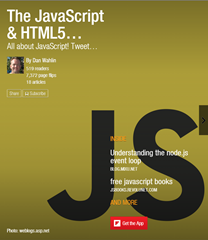Pluralsight Meet the Author Podcast on Structuring JavaScript Code

I had the opportunity to talk with Fritz Onion from Pluralsight about one of my recent courses titled Structuring JavaScript Code for one of their Meet the Author podcasts. We talked about why JavaScript patterns are important for building more re-useable and maintainable apps, pros and cons of different patterns, and how to go about picking a pattern as a project is started. The course provides a solid walk-through of converting what I call “Function Spaghetti Code” into more modular code that’s easier to maintain, more re-useable, and less susceptible to naming conflicts. Patterns covered in the course include the Prototype Pattern, Revealing Module Pattern, and Revealing Prototype Pattern along with several other tips and techniques that can be used.
 Meet the Author: Dan Wahlin on Structuring JavaScript Code
Meet the Author: Dan Wahlin on Structuring JavaScript Code
The transcript from the podcast is shown below:
[Fritz] Hello, this is Fritz Onion with another Pluralsight author interview. Today we’re talking with Dan Wahlin about his new course, Structuring JavaScript Code. Hi, Dan, it’s good to have you with us today.
[Dan] Thanks for having me, Fritz.
[Fritz] So, Dan, your new course, which came out in December of 2011 called Structuring JavaScript Code, goes into several patterns of usage in JavaScript as well as ways of organizing your code and what struck me about it was all the different techniques you described for encapsulating your code. I was wondering if you could give us just a little insight into what your motivation was for creating this course and sort of why you decided to write it and record it.
[Dan] Sure. So, I got started with JavaScript back in the mid 90s. In fact, back in the days when browsers that most people haven’t heard of were out and we had JavaScript but it wasn’t great. I was on a project in the late 90s that was heavy, heavy JavaScript and we pretty much did what I call in the course function spaghetti code where you just have function after function, there’s no rhyme or reason to how those functions are structured, they just kind of flow and it’s a little bit hard to do maintenance on it, you really don’t get a lot of reuse as far as from an object perspective. And so coming from an object-oriented background in JAVA and C#, I wanted to put something together that highlighted kind of the new way if you will of writing JavaScript because most people start out just writing functions and there’s nothing with that, it works, but it’s definitely not a real reusable solution. So the course is really all about how to move from just kind of function after function after function to the world of more encapsulated code and more reusable and hopefully better maintenance in the process.
[Fritz] So I am sure a lot of people have had similar experiences with their JavaScript code and will be looking forward to seeing what types of patterns you’ve put forth. Now, a couple I noticed in your course one is you start off with the prototype pattern. Do you want to describe sort of what problem that solves and how you go about using it within JavaScript?
[Dan] Sure. So, the patterns that are covered such as the prototype pattern and the revealing module pattern just as two examples, you know, show these kind of three things that I harp on throughout the course of encapsulation, better maintenance, reuse, those types of things. The prototype pattern specifically though has a couple kind of pros over some of the other patterns and that is the ability to extend your code without touching source code and what I mean by that is let’s say you’re writing a library that you know either other teammates or other people just out there on the Internet in general are going to be using. With the prototype pattern, you can actually write your code in such a way that we’re leveraging the JavaScript property and by doing that now you can extend my code that I wrote without touching my source code script or you can even override my code and perform some new functionality. Again, without touching my code. And so you get kind of the benefit of the almost like inheritance or overriding in object oriented languages with this prototype pattern and it makes it kind of attractive that way definitely from a maintenance standpoint because, you know, you don’t want to modify a script I wrote because I might roll out version 2 and now you’d have to track where you change things and it gets a little tricky. So with this you just override those pieces or extend them and get that functionality and that’s kind of some of the benefits that that pattern offers out of the box.
[Fritz] And then the revealing module pattern, how does that differ from the prototype pattern and what problem does that solve differently?
[Dan] Yeah, so the prototype pattern and there’s another one that’s kind of really closely lined with revealing module pattern called the revealing prototype pattern and it also uses the prototype key word but it’s very similar to the one you just asked about the revealing module pattern.
[Fritz] Okay.
[Dan] This is a really popular one out there. In fact, we did a project for Microsoft that was very, very heavy JavaScript. It was an HMTL5 jQuery type app and we use this pattern for most of the structure if you will for the JavaScript code and what it does in a nutshell is allows you to get that encapsulation so you have really a single function wrapper that wraps all your other child functions but it gives you the ability to do public versus private members and this is kind of a sort of debate out there on the web. Some people feel that all JavaScript code should just be directly accessible and others kind of like to be able to hide their, truly their private stuff and a lot of people do that. You just put an underscore in front of your field or your variable name or your function name and that kind of is the defacto way to say hey, this is private. With the revealing module pattern you can do the equivalent of what objective oriented languages do and actually have private members that you literally can’t get to as an external consumer of the JavaScript code and then you can expose only those members that you want to be public. Now, you don’t get the benefit though of the prototype feature, which is I can’t easily extend the revealing module pattern type code if you don’t like something I’m doing, chances are you’re probably going to have to tweak my code to fix that because we’re not leveraging prototyping but in situations where you’re writing apps that are very specific to a given target app, you know, it’s not a library, it’s not going to be used in other apps all over the place, it’s a pattern I actually like a lot, it’s very simple to get going and then if you do like that public/private feature, it’s available to you.
[Fritz] Yeah, that’s interesting. So it’s almost, you can either go private by convention just by using a standard naming convention or you can actually enforce it by using the prototype pattern.
[Dan] Yeah, that’s exactly right.
[Fritz] So one of the things that I know I run across in JavaScript and I’m curious to get your take on is we do have all these different techniques of encapsulation and each one is really quite different when you’re using closures versus simply, you know, referencing member variables and adding them to your objects that the syntax changes with each pattern and the usage changes. So what would you recommend for people starting out in a brand new JavaScript project? Should they all sort of decide beforehand on what patterns they’re going to stick to or do you change it based on what part of the library you’re working on? I know that’s one of the points of confusion in this space.
[Dan] Yeah, it’s a great question. In fact, I just had a company ask me about that. So which one do I pick and, of course, there’s not one answer fits all.
[Fritz] Right.
[Dan] So it really depends what you just said is absolutely in my opinion correct, which is I think as a, especially if you’re on a team or even if you’re just an individual a team of one, you should go through and pick out which pattern for this particular project you think is best. Now if it were me, here’s kind of the way I think of it. If I were writing a let’s say base library that several web apps are going to use or even one, but I know that there’s going to be some pieces that I’m not really sure on right now as I’m writing I and I know people might want to hook in that and have some better extension points, then I would look at either the prototype pattern or the revealing prototype. Now, really just a real quick summation between the two the revealing prototype also gives you that public/private stuff like the revealing module pattern does whereas the prototype pattern does not but both of the prototype patterns do give you the benefit of that extension or that hook capability. So, if I were writing a library that I need people to override things or I’m not even sure what I need them to override, I want them to have that option, I’d probably pick a prototype, one of the prototype patterns. If I’m writing some code that is very unique to the app and it’s kind of a one off for this app which is what I think a lot of people are kind of in that mode as writing custom apps for customers, then my personal preference is the revealing module pattern you could always go with the module pattern as well which is very close but I think the revealing module patterns a little bit cleaner and we go through that in the course and explain kind of the syntax there and the differences.
[Fritz] Great, that makes a lot of sense.
[Fritz] I appreciate you taking the time, Dan, and I hope everyone takes a chance to look at your course and sort of make these decisions for themselves in their next JavaScript project. Dan’s course is, Structuring JavaScript Code and it’s available now in the Pluralsight Library. So, thank you very much, Dan.
[Dan] Thanks for having me again.
Subscribe to my Free FlipBoard Magazines: | ||||
 |  |  |  |  |
